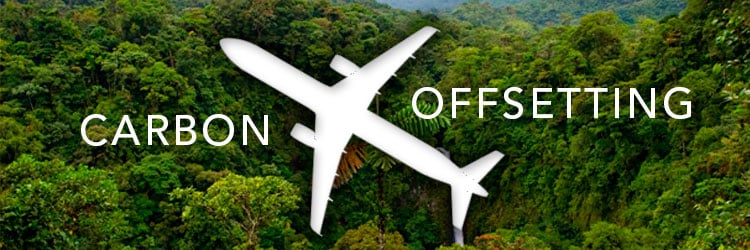Understanding Carbon Offsets – A Beginner’s Guide
As a group travel leader, you’re no doubt aware of the benefits of travel for your organization, institution, or chapter: Travel can build affinity among members, create educational opportunities, help your community feel more connected to your mission, and even be a great fundraising tool.
At the same time, it’s difficult to ignore travel’s potentially harmful effects on the environment in the form of greenhouse gases that contribute to climate change. (Did you know that if the airline industry were a country, it would be among the world's top 10 greenhouse-gas emitters?)
Does this mean you should cancel your organization’s travel program altogether and stay home? Not necessarily, but to be responsible travelers, it does mean you’ll need to take steps toward reducing your group’s carbon footprint. That’s where carbon offsetting comes in.
What is carbon offsetting?
In the simplest terms, carbon offsetting allows you to invest in environmental projects around the world that reduce or prevent greenhouse-gas emissions, thereby counteracting the effects of your actions elsewhere.
The concept dates back to the late 1970s, but a number of companies and non-profits have arisen since the early 2000s to offer this service; 3Degrees, NativeEnergy, Cool Effect, ClimateSafe, Sustainable Travel International, and Terrapass are just a handful of such providers.
How does it work?
After estimating the emissions produced by a certain activity (usually measured in tons of CO2), providers then calculate the amount of money needed to neutralize the same amount of emissions through the projects they fund, often in the renewable energy sector or in carbon capture and storage. For a 9-day trip to Costa Rica emitting 2.5 metric tons of CO2, an offset cost of $25 per person might be calculated, for example.
Various factors can affect how offset costs are determined, and some companies’ standards are more stringent then others. Some take into account the fact that airplane emissions are more harmful at higher altitudes, and multi-leg flights are more harmful than direct flights. Even the difference between flying first class and coach might be considered.
What kinds of projects can we support?
Different offset providers fund a variety of projects. Some focus their efforts in a certain region, while others fund projects in countries around the world. Some examples include funding reforestation initiatives, distributing more-efficient cook stoves, capturing methane gas at landfill sites, or investing in wind farms. As an added advantage, some projects also have social benefits that aid people in low-income neighborhoods or developing countries.
The Florida-based company ClimateSafe, for instance, supports projects in the US, Canada, and Costa Rica, including landfill gas-to-energy conversion, landfill gas destruction, destruction of ozone-depleting substances contained in refrigeration appliances, water-to-energy conversion, energy-efficient lighting conversion, carbon sequestration via reforestation, and a native honeybee project.
If your organization, institution, or chapter is already involved in conservation work related to a certain field or area of focus, you may wish to seek out projects that align specifically with those goals or that tie in with your overall mission.
How do we get started?
As a group leader, you can opt to include a mandatory carbon offset into the price of your trip. Many group travel providers offer the option to bundle carbon offset for you. Check with your travel provider to see which carbon offset company they use and what projects they support.
If your travel provider doesn’t offer this service, you can use an online tool to calculate the emissions from your trip yourself. Ask the travel provider to build that cost into the trip, and then your organization can donate directly to the offset company of your choosing. Two such tools that are known for having more rigorous criteria are carbonfootprint.com and carbonfund.org.
How do we know where our money is going?
There are many reputable carbon offset providers, but smart travelers should do their due diligence. It’s important to understand what you’re supporting, and any company you fund should be transparent about exactly where your dollars are going.
As you evaluate offset providers and projects, two common phrases you’ll come across are “additionality” and “leakage.” First, you want to make sure the project you support is doing something additional, or something that wouldn’t have happened anyway. For instance, if an energy project is mandated by law, then you’d be funding something that would have been implemented no matter what; your dollars are not doing anything additional.
Secondly, leakage refers to a project where an organization knowingly or unknowingly increases its emissions elsewhere. For example, if a project funds the protection of a tract of rainforest, but that just pushes a lumber company to cut down a different tract of rainforest, then the project hasn’t really accomplished anything.
Things like additionality and leakage are sometimes difficult to prove, but they’re important concepts to be aware of. That said, there are several reputable third-party certification systems that evaluate offset providers to help you make a more informed decision. Voluntary Gold Standard, Voluntary Carbon Standard, Green-e, and Climate Action Reserve are a good place to start.
Does carbon offsetting really help?
Carbon offsetting is not without its critics. Environmentalists have voiced concerns that the practice is an “easy out” that absolves our conscience and lets us off the hook without asking us to change our harmful actions. Others have suggested that offsets by individuals and small businesses take the pressure off governments and corporations to make the large-scale changes necessary to combat climate change.
Done right, however, the projects funded by carbon offsetting can have real and tangible results. And together with other strategies like reducing energy usage, generating less waste, and mitigating the effects of overtourism, carbon offsetting can be incorporated into a more responsible approach to your organization’s travel program.


